Article Critique: Education Program for Mothers of Children with ASD
VerifiedAdded on 2020/03/04
|9
|2297
|84
Report
AI Summary
This report offers a critical analysis of the quantitative study "The Effect of an Education Program for Mothers of Children with Autism Spectrum Disorder in Jordan" by Al-Khalaf et al. (2013). The paper evaluates the research's appropriateness, design, methodology, and findings, focusing on the impact of education programs on mothers' coping skills, stress levels, and understanding of their children's behavior. The study's strengths include its exploratory design, which helps to bridge the gap in knowledge regarding the value of educational programs. However, the analysis also highlights limitations, such as a small sample size, lack of a control group, and short program duration, affecting the study's validity and generalizability. Despite these limitations, the report acknowledges the study's valuable insights into the experiences and perceptions of parents of children with ASD, emphasizing its potential to inform the development of effective parent training programs.
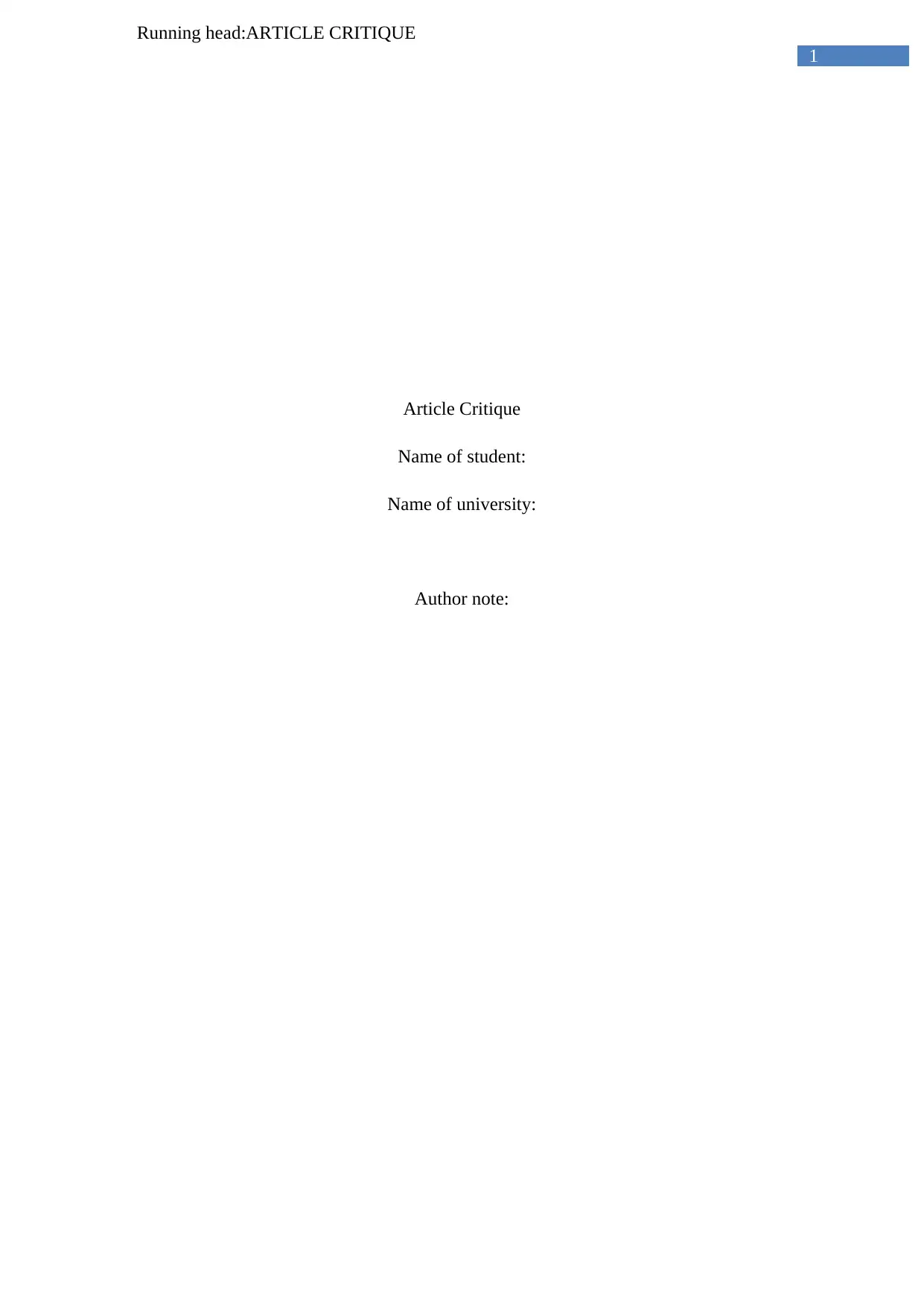
1
Running head:ARTICLE CRITIQUE
Article Critique
Name of student:
Name of university:
Author note:
Running head:ARTICLE CRITIQUE
Article Critique
Name of student:
Name of university:
Author note:
Paraphrase This Document
Need a fresh take? Get an instant paraphrase of this document with our AI Paraphraser
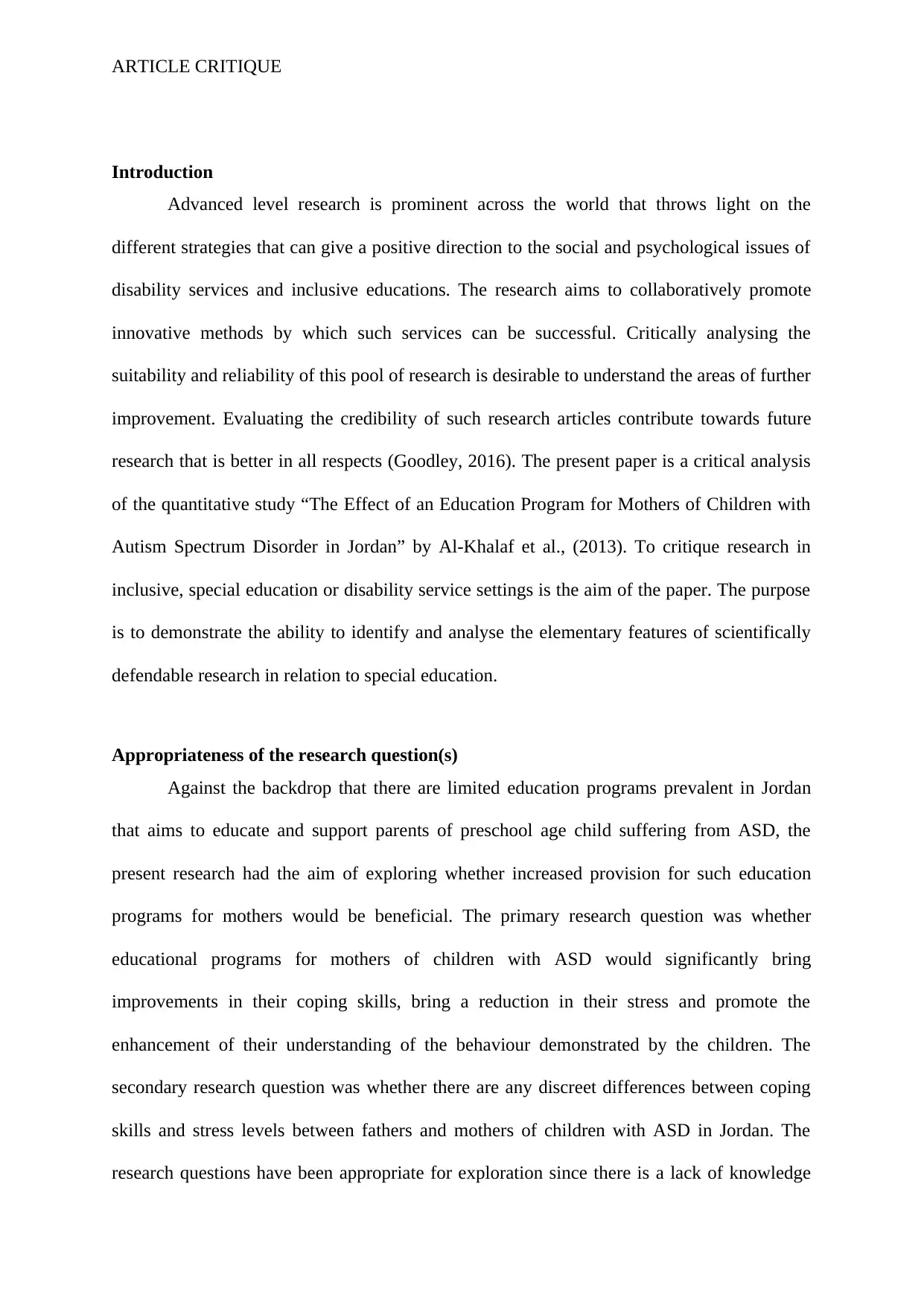
ARTICLE CRITIQUE
Introduction
Advanced level research is prominent across the world that throws light on the
different strategies that can give a positive direction to the social and psychological issues of
disability services and inclusive educations. The research aims to collaboratively promote
innovative methods by which such services can be successful. Critically analysing the
suitability and reliability of this pool of research is desirable to understand the areas of further
improvement. Evaluating the credibility of such research articles contribute towards future
research that is better in all respects (Goodley, 2016). The present paper is a critical analysis
of the quantitative study “The Effect of an Education Program for Mothers of Children with
Autism Spectrum Disorder in Jordan” by Al-Khalaf et al., (2013). To critique research in
inclusive, special education or disability service settings is the aim of the paper. The purpose
is to demonstrate the ability to identify and analyse the elementary features of scientifically
defendable research in relation to special education.
Appropriateness of the research question(s)
Against the backdrop that there are limited education programs prevalent in Jordan
that aims to educate and support parents of preschool age child suffering from ASD, the
present research had the aim of exploring whether increased provision for such education
programs for mothers would be beneficial. The primary research question was whether
educational programs for mothers of children with ASD would significantly bring
improvements in their coping skills, bring a reduction in their stress and promote the
enhancement of their understanding of the behaviour demonstrated by the children. The
secondary research question was whether there are any discreet differences between coping
skills and stress levels between fathers and mothers of children with ASD in Jordan. The
research questions have been appropriate for exploration since there is a lack of knowledge
Introduction
Advanced level research is prominent across the world that throws light on the
different strategies that can give a positive direction to the social and psychological issues of
disability services and inclusive educations. The research aims to collaboratively promote
innovative methods by which such services can be successful. Critically analysing the
suitability and reliability of this pool of research is desirable to understand the areas of further
improvement. Evaluating the credibility of such research articles contribute towards future
research that is better in all respects (Goodley, 2016). The present paper is a critical analysis
of the quantitative study “The Effect of an Education Program for Mothers of Children with
Autism Spectrum Disorder in Jordan” by Al-Khalaf et al., (2013). To critique research in
inclusive, special education or disability service settings is the aim of the paper. The purpose
is to demonstrate the ability to identify and analyse the elementary features of scientifically
defendable research in relation to special education.
Appropriateness of the research question(s)
Against the backdrop that there are limited education programs prevalent in Jordan
that aims to educate and support parents of preschool age child suffering from ASD, the
present research had the aim of exploring whether increased provision for such education
programs for mothers would be beneficial. The primary research question was whether
educational programs for mothers of children with ASD would significantly bring
improvements in their coping skills, bring a reduction in their stress and promote the
enhancement of their understanding of the behaviour demonstrated by the children. The
secondary research question was whether there are any discreet differences between coping
skills and stress levels between fathers and mothers of children with ASD in Jordan. The
research questions have been appropriate for exploration since there is a lack of knowledge
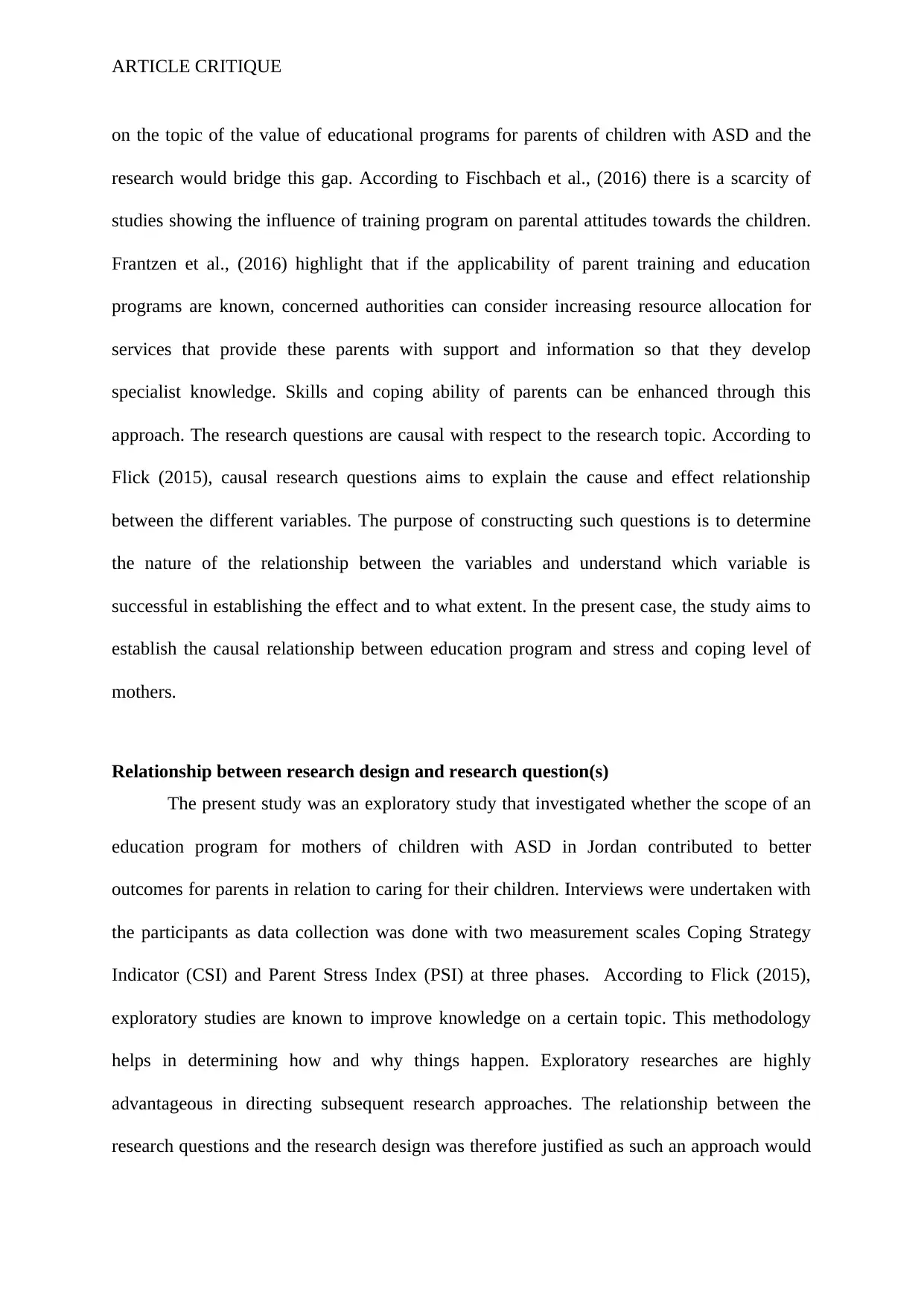
ARTICLE CRITIQUE
on the topic of the value of educational programs for parents of children with ASD and the
research would bridge this gap. According to Fischbach et al., (2016) there is a scarcity of
studies showing the influence of training program on parental attitudes towards the children.
Frantzen et al., (2016) highlight that if the applicability of parent training and education
programs are known, concerned authorities can consider increasing resource allocation for
services that provide these parents with support and information so that they develop
specialist knowledge. Skills and coping ability of parents can be enhanced through this
approach. The research questions are causal with respect to the research topic. According to
Flick (2015), causal research questions aims to explain the cause and effect relationship
between the different variables. The purpose of constructing such questions is to determine
the nature of the relationship between the variables and understand which variable is
successful in establishing the effect and to what extent. In the present case, the study aims to
establish the causal relationship between education program and stress and coping level of
mothers.
Relationship between research design and research question(s)
The present study was an exploratory study that investigated whether the scope of an
education program for mothers of children with ASD in Jordan contributed to better
outcomes for parents in relation to caring for their children. Interviews were undertaken with
the participants as data collection was done with two measurement scales Coping Strategy
Indicator (CSI) and Parent Stress Index (PSI) at three phases. According to Flick (2015),
exploratory studies are known to improve knowledge on a certain topic. This methodology
helps in determining how and why things happen. Exploratory researches are highly
advantageous in directing subsequent research approaches. The relationship between the
research questions and the research design was therefore justified as such an approach would
on the topic of the value of educational programs for parents of children with ASD and the
research would bridge this gap. According to Fischbach et al., (2016) there is a scarcity of
studies showing the influence of training program on parental attitudes towards the children.
Frantzen et al., (2016) highlight that if the applicability of parent training and education
programs are known, concerned authorities can consider increasing resource allocation for
services that provide these parents with support and information so that they develop
specialist knowledge. Skills and coping ability of parents can be enhanced through this
approach. The research questions are causal with respect to the research topic. According to
Flick (2015), causal research questions aims to explain the cause and effect relationship
between the different variables. The purpose of constructing such questions is to determine
the nature of the relationship between the variables and understand which variable is
successful in establishing the effect and to what extent. In the present case, the study aims to
establish the causal relationship between education program and stress and coping level of
mothers.
Relationship between research design and research question(s)
The present study was an exploratory study that investigated whether the scope of an
education program for mothers of children with ASD in Jordan contributed to better
outcomes for parents in relation to caring for their children. Interviews were undertaken with
the participants as data collection was done with two measurement scales Coping Strategy
Indicator (CSI) and Parent Stress Index (PSI) at three phases. According to Flick (2015),
exploratory studies are known to improve knowledge on a certain topic. This methodology
helps in determining how and why things happen. Exploratory researches are highly
advantageous in directing subsequent research approaches. The relationship between the
research questions and the research design was therefore justified as such an approach would
⊘ This is a preview!⊘
Do you want full access?
Subscribe today to unlock all pages.

Trusted by 1+ million students worldwide
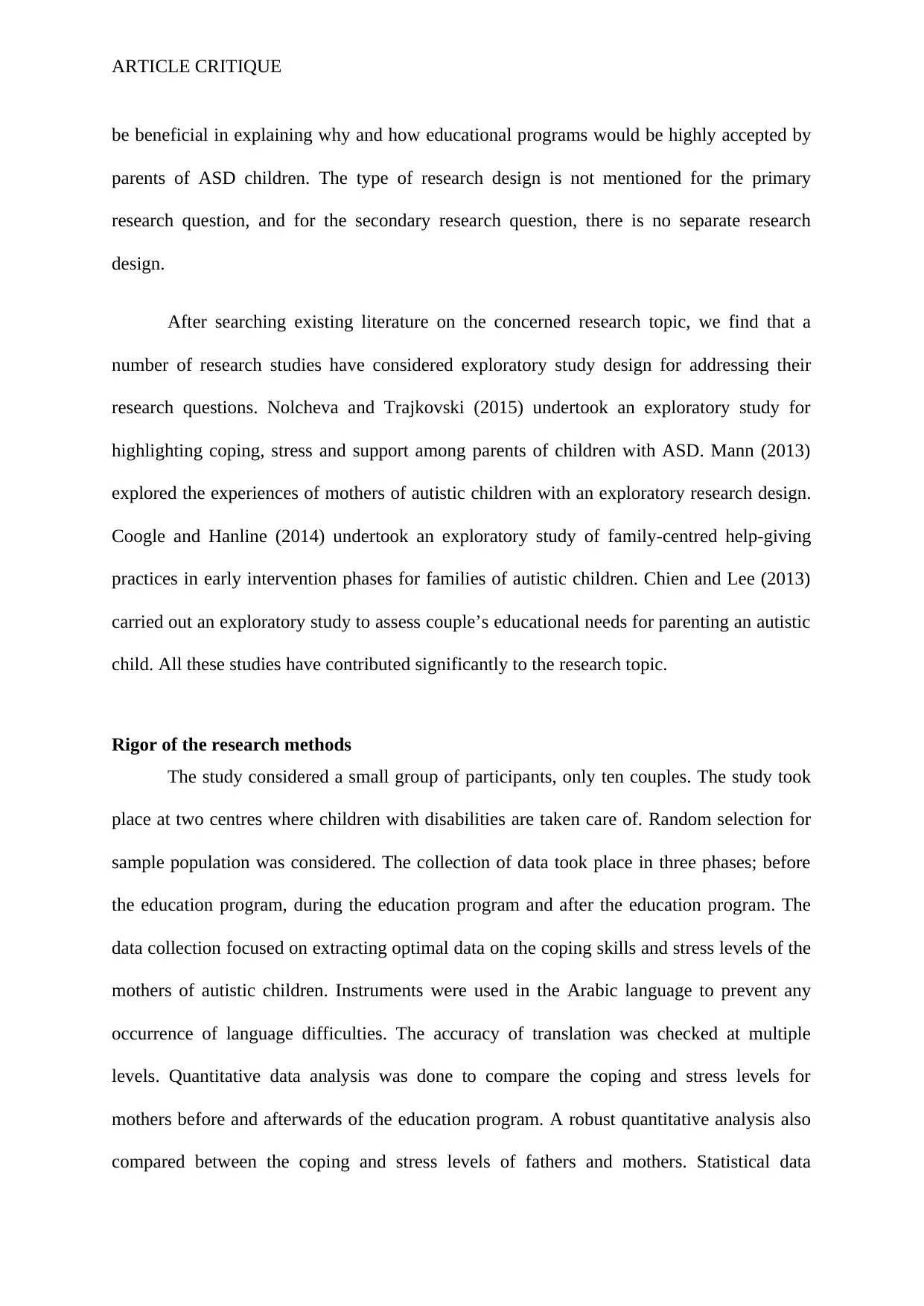
ARTICLE CRITIQUE
be beneficial in explaining why and how educational programs would be highly accepted by
parents of ASD children. The type of research design is not mentioned for the primary
research question, and for the secondary research question, there is no separate research
design.
After searching existing literature on the concerned research topic, we find that a
number of research studies have considered exploratory study design for addressing their
research questions. Nolcheva and Trajkovski (2015) undertook an exploratory study for
highlighting coping, stress and support among parents of children with ASD. Mann (2013)
explored the experiences of mothers of autistic children with an exploratory research design.
Coogle and Hanline (2014) undertook an exploratory study of family-centred help-giving
practices in early intervention phases for families of autistic children. Chien and Lee (2013)
carried out an exploratory study to assess couple’s educational needs for parenting an autistic
child. All these studies have contributed significantly to the research topic.
Rigor of the research methods
The study considered a small group of participants, only ten couples. The study took
place at two centres where children with disabilities are taken care of. Random selection for
sample population was considered. The collection of data took place in three phases; before
the education program, during the education program and after the education program. The
data collection focused on extracting optimal data on the coping skills and stress levels of the
mothers of autistic children. Instruments were used in the Arabic language to prevent any
occurrence of language difficulties. The accuracy of translation was checked at multiple
levels. Quantitative data analysis was done to compare the coping and stress levels for
mothers before and afterwards of the education program. A robust quantitative analysis also
compared between the coping and stress levels of fathers and mothers. Statistical data
be beneficial in explaining why and how educational programs would be highly accepted by
parents of ASD children. The type of research design is not mentioned for the primary
research question, and for the secondary research question, there is no separate research
design.
After searching existing literature on the concerned research topic, we find that a
number of research studies have considered exploratory study design for addressing their
research questions. Nolcheva and Trajkovski (2015) undertook an exploratory study for
highlighting coping, stress and support among parents of children with ASD. Mann (2013)
explored the experiences of mothers of autistic children with an exploratory research design.
Coogle and Hanline (2014) undertook an exploratory study of family-centred help-giving
practices in early intervention phases for families of autistic children. Chien and Lee (2013)
carried out an exploratory study to assess couple’s educational needs for parenting an autistic
child. All these studies have contributed significantly to the research topic.
Rigor of the research methods
The study considered a small group of participants, only ten couples. The study took
place at two centres where children with disabilities are taken care of. Random selection for
sample population was considered. The collection of data took place in three phases; before
the education program, during the education program and after the education program. The
data collection focused on extracting optimal data on the coping skills and stress levels of the
mothers of autistic children. Instruments were used in the Arabic language to prevent any
occurrence of language difficulties. The accuracy of translation was checked at multiple
levels. Quantitative data analysis was done to compare the coping and stress levels for
mothers before and afterwards of the education program. A robust quantitative analysis also
compared between the coping and stress levels of fathers and mothers. Statistical data
Paraphrase This Document
Need a fresh take? Get an instant paraphrase of this document with our AI Paraphraser
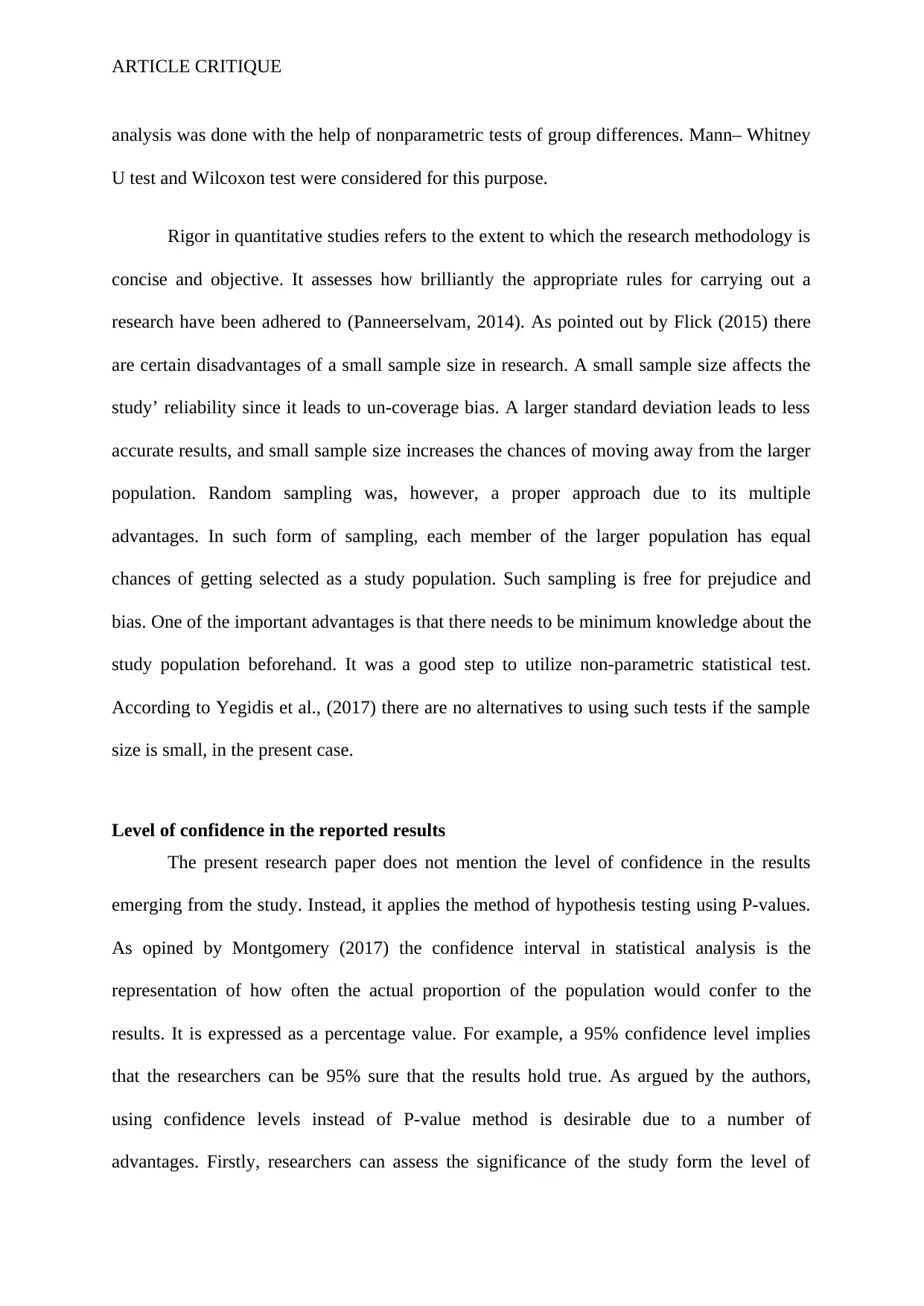
ARTICLE CRITIQUE
analysis was done with the help of nonparametric tests of group differences. Mann– Whitney
U test and Wilcoxon test were considered for this purpose.
Rigor in quantitative studies refers to the extent to which the research methodology is
concise and objective. It assesses how brilliantly the appropriate rules for carrying out a
research have been adhered to (Panneerselvam, 2014). As pointed out by Flick (2015) there
are certain disadvantages of a small sample size in research. A small sample size affects the
study’ reliability since it leads to un-coverage bias. A larger standard deviation leads to less
accurate results, and small sample size increases the chances of moving away from the larger
population. Random sampling was, however, a proper approach due to its multiple
advantages. In such form of sampling, each member of the larger population has equal
chances of getting selected as a study population. Such sampling is free for prejudice and
bias. One of the important advantages is that there needs to be minimum knowledge about the
study population beforehand. It was a good step to utilize non-parametric statistical test.
According to Yegidis et al., (2017) there are no alternatives to using such tests if the sample
size is small, in the present case.
Level of confidence in the reported results
The present research paper does not mention the level of confidence in the results
emerging from the study. Instead, it applies the method of hypothesis testing using P-values.
As opined by Montgomery (2017) the confidence interval in statistical analysis is the
representation of how often the actual proportion of the population would confer to the
results. It is expressed as a percentage value. For example, a 95% confidence level implies
that the researchers can be 95% sure that the results hold true. As argued by the authors,
using confidence levels instead of P-value method is desirable due to a number of
advantages. Firstly, researchers can assess the significance of the study form the level of
analysis was done with the help of nonparametric tests of group differences. Mann– Whitney
U test and Wilcoxon test were considered for this purpose.
Rigor in quantitative studies refers to the extent to which the research methodology is
concise and objective. It assesses how brilliantly the appropriate rules for carrying out a
research have been adhered to (Panneerselvam, 2014). As pointed out by Flick (2015) there
are certain disadvantages of a small sample size in research. A small sample size affects the
study’ reliability since it leads to un-coverage bias. A larger standard deviation leads to less
accurate results, and small sample size increases the chances of moving away from the larger
population. Random sampling was, however, a proper approach due to its multiple
advantages. In such form of sampling, each member of the larger population has equal
chances of getting selected as a study population. Such sampling is free for prejudice and
bias. One of the important advantages is that there needs to be minimum knowledge about the
study population beforehand. It was a good step to utilize non-parametric statistical test.
According to Yegidis et al., (2017) there are no alternatives to using such tests if the sample
size is small, in the present case.
Level of confidence in the reported results
The present research paper does not mention the level of confidence in the results
emerging from the study. Instead, it applies the method of hypothesis testing using P-values.
As opined by Montgomery (2017) the confidence interval in statistical analysis is the
representation of how often the actual proportion of the population would confer to the
results. It is expressed as a percentage value. For example, a 95% confidence level implies
that the researchers can be 95% sure that the results hold true. As argued by the authors,
using confidence levels instead of P-value method is desirable due to a number of
advantages. Firstly, researchers can assess the significance of the study form the level of
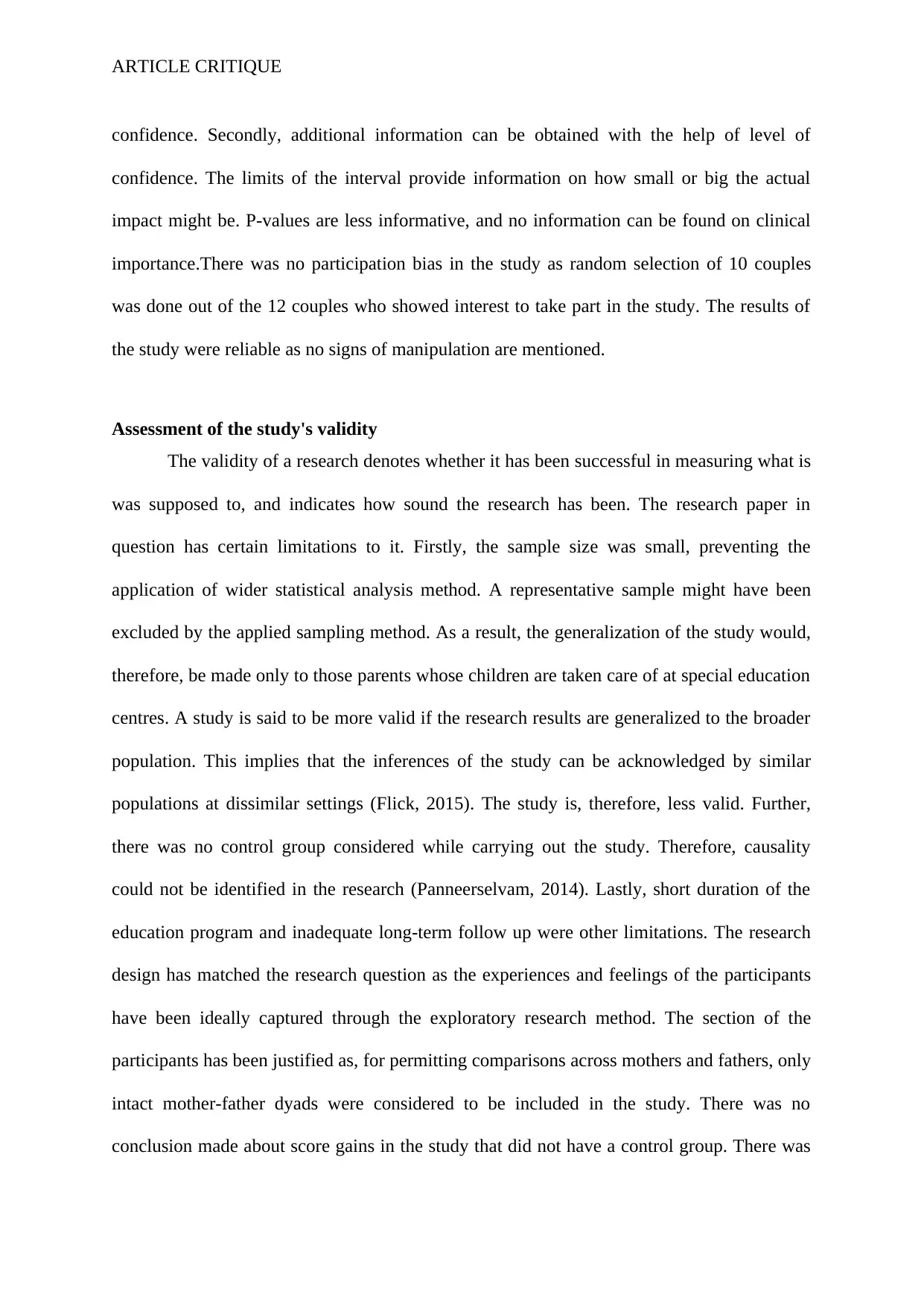
ARTICLE CRITIQUE
confidence. Secondly, additional information can be obtained with the help of level of
confidence. The limits of the interval provide information on how small or big the actual
impact might be. P-values are less informative, and no information can be found on clinical
importance.There was no participation bias in the study as random selection of 10 couples
was done out of the 12 couples who showed interest to take part in the study. The results of
the study were reliable as no signs of manipulation are mentioned.
Assessment of the study's validity
The validity of a research denotes whether it has been successful in measuring what is
was supposed to, and indicates how sound the research has been. The research paper in
question has certain limitations to it. Firstly, the sample size was small, preventing the
application of wider statistical analysis method. A representative sample might have been
excluded by the applied sampling method. As a result, the generalization of the study would,
therefore, be made only to those parents whose children are taken care of at special education
centres. A study is said to be more valid if the research results are generalized to the broader
population. This implies that the inferences of the study can be acknowledged by similar
populations at dissimilar settings (Flick, 2015). The study is, therefore, less valid. Further,
there was no control group considered while carrying out the study. Therefore, causality
could not be identified in the research (Panneerselvam, 2014). Lastly, short duration of the
education program and inadequate long-term follow up were other limitations. The research
design has matched the research question as the experiences and feelings of the participants
have been ideally captured through the exploratory research method. The section of the
participants has been justified as, for permitting comparisons across mothers and fathers, only
intact mother-father dyads were considered to be included in the study. There was no
conclusion made about score gains in the study that did not have a control group. There was
confidence. Secondly, additional information can be obtained with the help of level of
confidence. The limits of the interval provide information on how small or big the actual
impact might be. P-values are less informative, and no information can be found on clinical
importance.There was no participation bias in the study as random selection of 10 couples
was done out of the 12 couples who showed interest to take part in the study. The results of
the study were reliable as no signs of manipulation are mentioned.
Assessment of the study's validity
The validity of a research denotes whether it has been successful in measuring what is
was supposed to, and indicates how sound the research has been. The research paper in
question has certain limitations to it. Firstly, the sample size was small, preventing the
application of wider statistical analysis method. A representative sample might have been
excluded by the applied sampling method. As a result, the generalization of the study would,
therefore, be made only to those parents whose children are taken care of at special education
centres. A study is said to be more valid if the research results are generalized to the broader
population. This implies that the inferences of the study can be acknowledged by similar
populations at dissimilar settings (Flick, 2015). The study is, therefore, less valid. Further,
there was no control group considered while carrying out the study. Therefore, causality
could not be identified in the research (Panneerselvam, 2014). Lastly, short duration of the
education program and inadequate long-term follow up were other limitations. The research
design has matched the research question as the experiences and feelings of the participants
have been ideally captured through the exploratory research method. The section of the
participants has been justified as, for permitting comparisons across mothers and fathers, only
intact mother-father dyads were considered to be included in the study. There was no
conclusion made about score gains in the study that did not have a control group. There was
⊘ This is a preview!⊘
Do you want full access?
Subscribe today to unlock all pages.

Trusted by 1+ million students worldwide
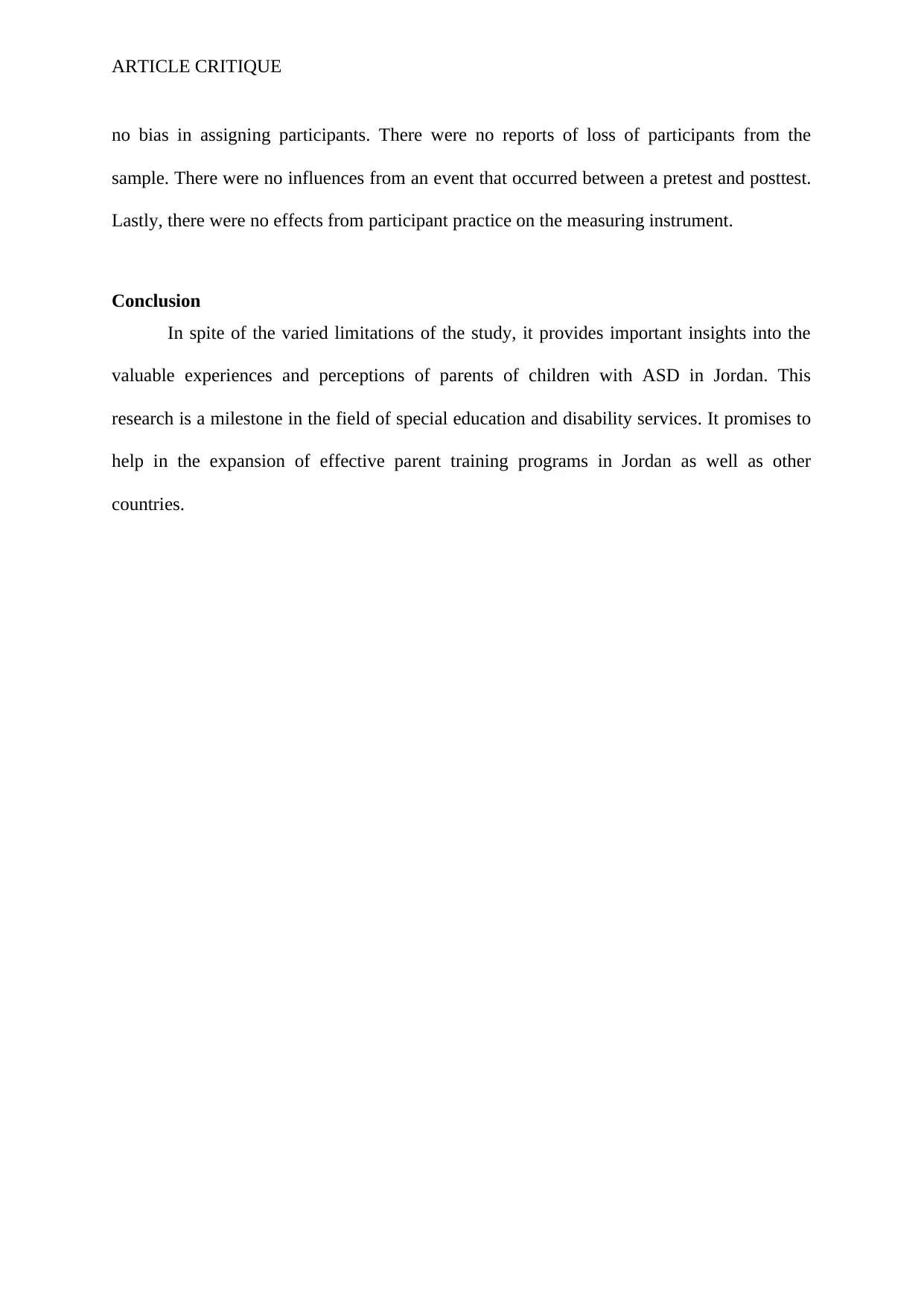
ARTICLE CRITIQUE
no bias in assigning participants. There were no reports of loss of participants from the
sample. There were no influences from an event that occurred between a pretest and posttest.
Lastly, there were no effects from participant practice on the measuring instrument.
Conclusion
In spite of the varied limitations of the study, it provides important insights into the
valuable experiences and perceptions of parents of children with ASD in Jordan. This
research is a milestone in the field of special education and disability services. It promises to
help in the expansion of effective parent training programs in Jordan as well as other
countries.
no bias in assigning participants. There were no reports of loss of participants from the
sample. There were no influences from an event that occurred between a pretest and posttest.
Lastly, there were no effects from participant practice on the measuring instrument.
Conclusion
In spite of the varied limitations of the study, it provides important insights into the
valuable experiences and perceptions of parents of children with ASD in Jordan. This
research is a milestone in the field of special education and disability services. It promises to
help in the expansion of effective parent training programs in Jordan as well as other
countries.
Paraphrase This Document
Need a fresh take? Get an instant paraphrase of this document with our AI Paraphraser
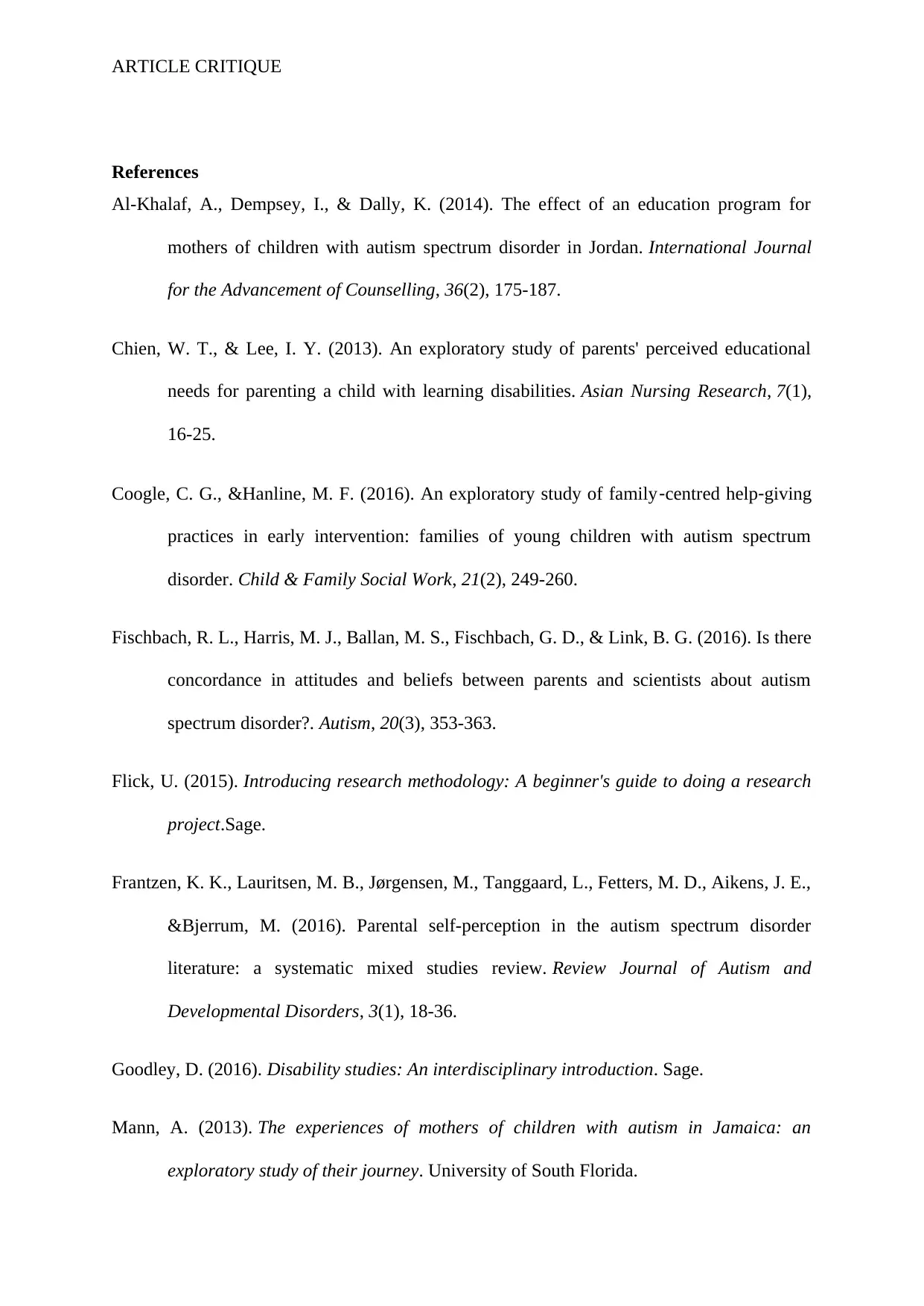
ARTICLE CRITIQUE
References
Al-Khalaf, A., Dempsey, I., & Dally, K. (2014). The effect of an education program for
mothers of children with autism spectrum disorder in Jordan. International Journal
for the Advancement of Counselling, 36(2), 175-187.
Chien, W. T., & Lee, I. Y. (2013). An exploratory study of parents' perceived educational
needs for parenting a child with learning disabilities. Asian Nursing Research, 7(1),
16-25.
Coogle, C. G., &Hanline, M. F. (2016). An exploratory study of family‐centred help‐giving
practices in early intervention: families of young children with autism spectrum
disorder. Child & Family Social Work, 21(2), 249-260.
Fischbach, R. L., Harris, M. J., Ballan, M. S., Fischbach, G. D., & Link, B. G. (2016). Is there
concordance in attitudes and beliefs between parents and scientists about autism
spectrum disorder?. Autism, 20(3), 353-363.
Flick, U. (2015). Introducing research methodology: A beginner's guide to doing a research
project.Sage.
Frantzen, K. K., Lauritsen, M. B., Jørgensen, M., Tanggaard, L., Fetters, M. D., Aikens, J. E.,
&Bjerrum, M. (2016). Parental self-perception in the autism spectrum disorder
literature: a systematic mixed studies review. Review Journal of Autism and
Developmental Disorders, 3(1), 18-36.
Goodley, D. (2016). Disability studies: An interdisciplinary introduction. Sage.
Mann, A. (2013). The experiences of mothers of children with autism in Jamaica: an
exploratory study of their journey. University of South Florida.
References
Al-Khalaf, A., Dempsey, I., & Dally, K. (2014). The effect of an education program for
mothers of children with autism spectrum disorder in Jordan. International Journal
for the Advancement of Counselling, 36(2), 175-187.
Chien, W. T., & Lee, I. Y. (2013). An exploratory study of parents' perceived educational
needs for parenting a child with learning disabilities. Asian Nursing Research, 7(1),
16-25.
Coogle, C. G., &Hanline, M. F. (2016). An exploratory study of family‐centred help‐giving
practices in early intervention: families of young children with autism spectrum
disorder. Child & Family Social Work, 21(2), 249-260.
Fischbach, R. L., Harris, M. J., Ballan, M. S., Fischbach, G. D., & Link, B. G. (2016). Is there
concordance in attitudes and beliefs between parents and scientists about autism
spectrum disorder?. Autism, 20(3), 353-363.
Flick, U. (2015). Introducing research methodology: A beginner's guide to doing a research
project.Sage.
Frantzen, K. K., Lauritsen, M. B., Jørgensen, M., Tanggaard, L., Fetters, M. D., Aikens, J. E.,
&Bjerrum, M. (2016). Parental self-perception in the autism spectrum disorder
literature: a systematic mixed studies review. Review Journal of Autism and
Developmental Disorders, 3(1), 18-36.
Goodley, D. (2016). Disability studies: An interdisciplinary introduction. Sage.
Mann, A. (2013). The experiences of mothers of children with autism in Jamaica: an
exploratory study of their journey. University of South Florida.
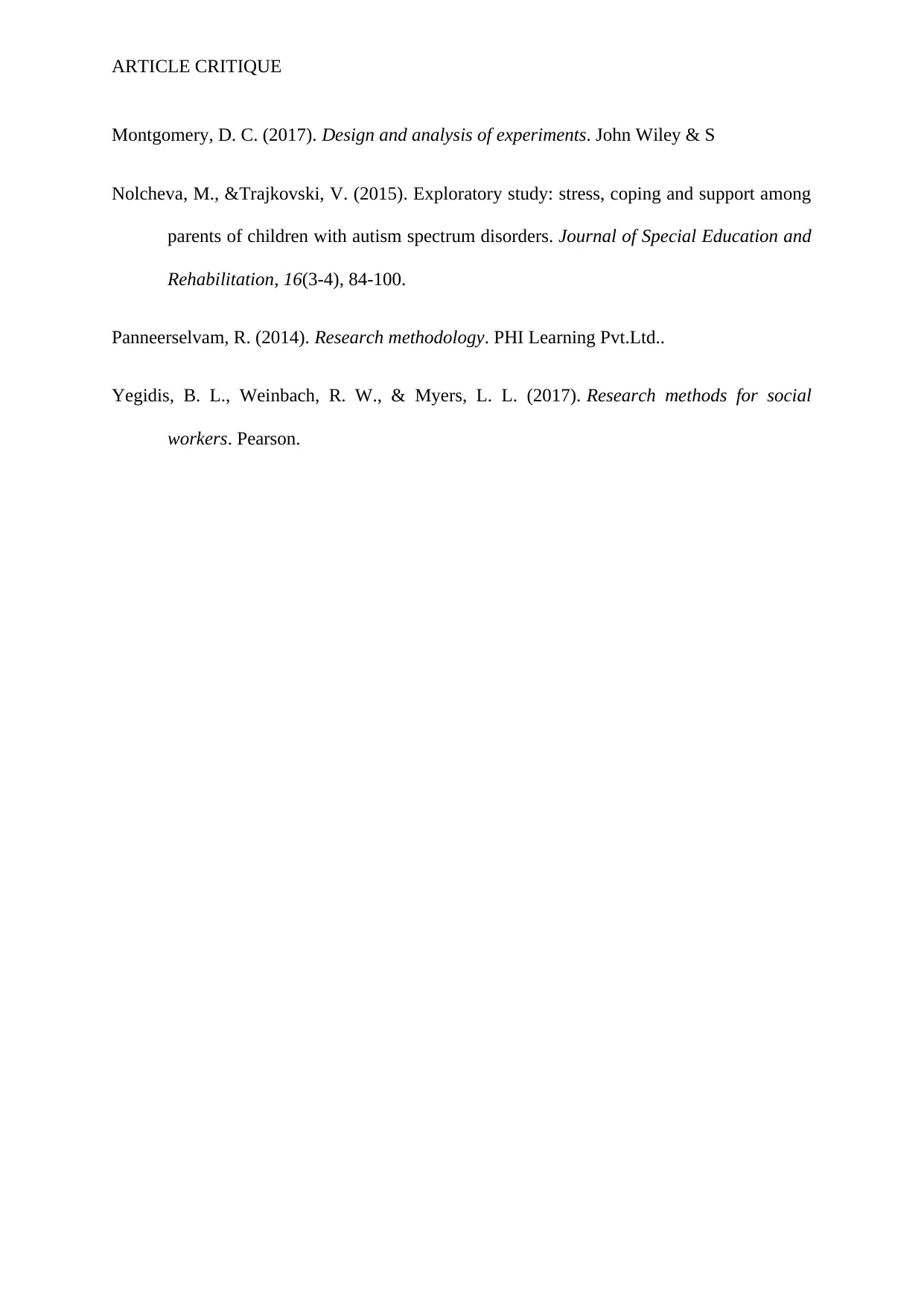
ARTICLE CRITIQUE
Montgomery, D. C. (2017). Design and analysis of experiments. John Wiley & S
Nolcheva, M., &Trajkovski, V. (2015). Exploratory study: stress, coping and support among
parents of children with autism spectrum disorders. Journal of Special Education and
Rehabilitation, 16(3-4), 84-100.
Panneerselvam, R. (2014). Research methodology. PHI Learning Pvt.Ltd..
Yegidis, B. L., Weinbach, R. W., & Myers, L. L. (2017). Research methods for social
workers. Pearson.
Montgomery, D. C. (2017). Design and analysis of experiments. John Wiley & S
Nolcheva, M., &Trajkovski, V. (2015). Exploratory study: stress, coping and support among
parents of children with autism spectrum disorders. Journal of Special Education and
Rehabilitation, 16(3-4), 84-100.
Panneerselvam, R. (2014). Research methodology. PHI Learning Pvt.Ltd..
Yegidis, B. L., Weinbach, R. W., & Myers, L. L. (2017). Research methods for social
workers. Pearson.
⊘ This is a preview!⊘
Do you want full access?
Subscribe today to unlock all pages.

Trusted by 1+ million students worldwide
1 out of 9
Related Documents
Your All-in-One AI-Powered Toolkit for Academic Success.
+13062052269
info@desklib.com
Available 24*7 on WhatsApp / Email
![[object Object]](/_next/static/media/star-bottom.7253800d.svg)
Unlock your academic potential
Copyright © 2020–2025 A2Z Services. All Rights Reserved. Developed and managed by ZUCOL.





